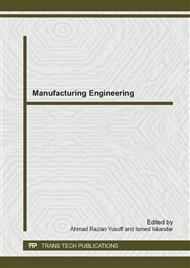[1]
J. Womack, Lean Thinking Banish waste and create wealth in your corporation,. Free Press, (2003).
Google Scholar
[2]
J. Liker, The Toyota way 14 management principles,. McGraw-Hill, (2004).
Google Scholar
[3]
M. P. Groover, Automation, Production Systems, and Computer-Integrated Manufacturing. Prentice Hall, (2007).
Google Scholar
[4]
T. Ohno, Toyota Production System, Beyond Large-Scale Production. New york: Productivity Press, (1988).
Google Scholar
[5]
Stephen P, D. A. Robbins, and M. C. DeCenzo, Fundamentals of Management. Pearson, (2012).
Google Scholar
[6]
E. L. Oral, G. Mıstıkoglu, and E. Erdis, JIT in developing countries—a case study of the Turkish prefabrication sector, Building and Environment, vol. 38, no. 6, p.853–860, Jun. (2003).
DOI: 10.1016/s0360-1323(03)00021-0
Google Scholar
[7]
Y. Monden, The relationship between mini profit-center and JIT system, International Journal of Production Economics, vol. 80, no. 2, p.145–154, Nov. (2002).
DOI: 10.1016/s0925-5273(02)00314-6
Google Scholar
[8]
G. Abdul-nour, S. Lambert, and J. Drolet, Adaptaion of JIT in SMEs, vol. 35, no. 98, p.419–422, (1998).
Google Scholar
[9]
L. C. Giunipero and C. O'Neal, Obstacles to JIT procurement, Industrial Marketing Management, vol. 17, no. 1, p.35–41, Feb. (1988).
DOI: 10.1016/0019-8501(88)90024-7
Google Scholar
[10]
J. Black, Design rules for implementing the Toyota Production System, International Journal of Production Research, vol. 45, no. 16, p.3639–3664, Aug. (2007).
DOI: 10.1080/00207540701223469
Google Scholar
[11]
J. R. Grout and J. S. Toussaint, Mistake-proofing healthcare: Why stopping processes may be a good start, Business Horizons, vol. 53, no. 2, p.149–156, Mar. (2010).
DOI: 10.1016/j.bushor.2009.10.007
Google Scholar
[12]
B. R. Staats, D. J. Brunner, and D. M. Upton, Lean principles, learning, and knowledge work: Evidence from a software services provider, Journal of Operations Management, vol. 29, no. 5, p.376–390, Jul. (2011).
DOI: 10.1016/j.jom.2010.11.005
Google Scholar
[13]
Q. HU, P. Found, S. Williams, and R. Mason, The connection between organizational learning and lean production, (2011).
Google Scholar
[14]
S. F. Slater and J. C. Narver, Market Orientation and the Learning Organization, vol. 59, no. 3, p.63–74, (1995).
Google Scholar
[15]
S. Slater and J. Narver, Market orientation and the learning organization, The Journal of Marketing, vol. 59, no. 3, p.63–74, (1995).
DOI: 10.1177/002224299505900306
Google Scholar
[16]
R. Choueke and R. Armstrong, The learning organisation in small and medium-sized enterprises: A destination or a journey?, International Journal of …, (1998).
DOI: 10.1108/13552559810224585
Google Scholar
[17]
A. V. Kovacheva, Challenges in Lean implementation Successful transformation towards Lean enterprise, University of Aarhus, (2010).
Google Scholar
[18]
D. Mann, The missing link: Lean leadership., Frontiers of health services management, vol. 26, no. 1, p.15–26, Jan. (2009).
DOI: 10.1097/01974520-200907000-00003
Google Scholar
[19]
Found, VanDun, and Fei, Multi-level Management and Leadership Skills in Lean Organizations, p.1–14, (2009).
Google Scholar
[20]
A. S. Sohal, Developing a lean production organization: an Australian case study, International Journal of Operations & Production Management, vol. 16, no. 2, p.91–102, (1996).
DOI: 10.1108/01443579610109866
Google Scholar
[21]
M. Spann, M. Adams, and M. Rahman, Transferring lean manufacturing to small manufacturers: The role of NIST-MEP, University of Alabama in Huntsville, (1999).
Google Scholar
[22]
P. Achanga and E. Shehab, Critical success factors for lean implementation within SMEs, Journal of Manufacturing …, (2006).
DOI: 10.1108/17410380610662889
Google Scholar
[23]
U. Dombrowski and I. Crespo, Strategy-oriented Qualification Framework as a Supporting Function of Lean Production System Implementation in Small and Medium-sized Enterprises, Manufacturing Systems and Technologies for …, p.77–82, (2008).
DOI: 10.1007/978-1-84800-267-8_15
Google Scholar
[24]
N. Upadhye, S. Deshmukh, and S. Garg, Lean manufacturing system for medium size manufacturing enterprises: an Indian case, International Journal of Management …, vol. 5, no. 5, p.362–375, (2010).
DOI: 10.1080/17509653.2010.10671127
Google Scholar
[25]
A. Rose, B. Deros, and M. Rahman, Development of framework for lean manufacturing implementation in SMEs, apiems. net, no. December, p.7–10, (2010).
Google Scholar
[26]
A. Rose and B. Deros, Lean manufacturing best practices in SMEs, Proceedings of the 2011 International Conference on Industrial Engineering and Operations Management Kuala Lumpur, Malaysia, p.872–877, (2011).
Google Scholar
[27]
R. Panizzolo, P. Garengo, M. K. Sharma, and A. Gore, Lean manufacturing in developing countries: evidence from Indian SMEs, Production Planning & Control, vol. 23, no. 10–11, p.769–788, Oct. (2011).
DOI: 10.1080/09537287.2011.642155
Google Scholar
[28]
P. Achanga, E. Shehab, R. Roy, and G. Nelder, A fuzzy-logic advisory system for lean manufacturing within SMEs, International Journal of Computer Integrated Manufacturing, vol. 25, no. 9, p.839–852, Sep. (2012).
DOI: 10.1080/0951192x.2012.665180
Google Scholar
[29]
C. Neumann, S. Kohlhuber, and S. Hanusch, Lean Production in Austrian Industrial Companies: An Empirical Investigation, p.293–312, (2012).
DOI: 10.1007/978-3-7908-2747-7_15
Google Scholar
[30]
B. Zhou, Lean principles, practices, and impacts: a study on small and medium-sized enterprises (SMEs), Annals of Operations Research, no. Krafcik 1988, Jul. (2012).
DOI: 10.1007/s10479-012-1177-3
Google Scholar
[31]
M. Yogesh, G. ChandraMohan, and R. Arrakal, Application of Lean in a Small and Medium Enterprise (SME) Segment-A Case Study of Electronics and Electrical Manufacturing Industry in India, International Journal of Scientific & Engineering Research, vol. 3, no. 8, p.1–8, (2012).
Google Scholar


